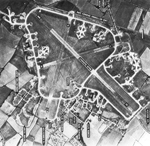Kimbolton railway station
1866 establishments in EnglandDisused railway stations in CambridgeshireEast of England railway station stubsFormer Midland Railway stationsPages with no open date in Infobox station ... and 3 more
Railway stations in Great Britain closed in 1959Railway stations in Great Britain opened in 1866Use British English from March 2015
Kimbolton railway station was a railway station in Kimbolton, Cambridgeshire. The station and its line closed in 1959. The journey from London St. Pancras took approximately three hours, and required a change of trains and a wait at Kettering. This journey was described by former Kimbolton School headmaster William Ingram as "long and wearisome", especially considering that the station was more than two miles away from the village centre.
Excerpt from the Wikipedia article Kimbolton railway station (License: CC BY-SA 3.0, Authors).Kimbolton railway station
B660, Huntingdonshire Tilbrook
Geographical coordinates (GPS) Address External links Nearby Places Show on map
Geographical coordinates (GPS)
| Latitude | Longitude |
|---|---|
| N 52.3271 ° | E -0.4053 ° |
Address
Kimbolton
B660
PE28 0JY Huntingdonshire, Tilbrook
England, United Kingdom
Open on Google Maps









